European Territorial Cooperation Programmes 2021-2027: consultation report
This report summarises the responses that the Scottish Government received to its consultation on European Territorial Cooperation Programmes for the period 2021-2027. The results of this consultation show that there is an overwhelming appetite from public sector organisations in Scotland for continued participation.
Programme Specific Responses
As previously stated, Scotland is currently involved in seven ETC programmes. This report will look at each programme in turn but will first discuss general findings for all programmes in relation to themes and priorities, geographical areas of importance and international cooperation through ETC.
Within ETC, programmes can pick a number of priorities to focus on. These priorities can be largely categorised under five headings: A Greener, Low Carbon Europe; A Smarter Europe; A More Social Europe; A More Connected Europe; and A Europe Closer to the Citizen. Question four of our consultation asked respondents to rank these priorities in order. The results can be seen in Table 1.
| Item | Ranking |
|---|---|
| A Greener, Low Carbon Europe | 4.43 |
| A Smarter Europe | 3.14 |
| A More Connected Europe | 2.62 |
| A Europe Closer to the Citizens | 2.33 |
| A More Social Europe | 2.19 |
It is clear from these results that Greener and Low Carbon priorities are of highest importance to respondents when using quantitative analysis. This is reflected in the comments that respondents had to the general questions on ETC and international cooperation. For example, Aberdeenshire Council stated that ideas for low carbon and green transport have been, and could continue to be, facilitated and tested through ETC programmes. Another public body noted that green priorities such as bio-diversity and climate change know no borders and require international collaboration to solve such issues.
Along those lines, “blue priorities” such as marine conservation, environmentally friendly marine transport and sustainable “blue economies” were important to respondents. “Scotland 's sea transport, tourism, marine bio tech and renewable energies would all benefit from cooperation, learning and peer to peer exchange, as well as funding opportunities,” according to The Scottish Islands Federation.
A Smart Europe and projects that could explore innovation, particularly around smart and inclusive growth but also in the health and social care sectors and education, were also deemed important. A business organisation commented how innovation will become even more important in the wake of the Covid-19 crisis. A More Connected Europe could be linked to this aspect of innovation through e-Health projects. These projects could focus on, but also learn from, remote and sparsely populated areas in the opinion of the same business organisation.
It is important to keep nuance in this report, and it is therefore important to reflect differences in quantitative and qualitative analysis. While a Europe Closer to the Citizen was ranked above A More Social Europe in the above table, our qualitative analysis of the long form questions on priorities for ETC programmes in general reflect a keen interest in the Social priority. A focus on the importance of cultural heritage and preserving it was evident in a few responses including by individuals and Historic Environment Scotland. The facilitation of knowledge transfer to improve public sector services was further noted by respondents as a potential area for exploration under this priority.
In addition to the above five priorities, there are also two Interreg Specific Priorities – Better Interreg Governance and A Safer, More Secure Europe. We asked in our consultation how many priorities programmes should focus on. The results are in Figure 3.
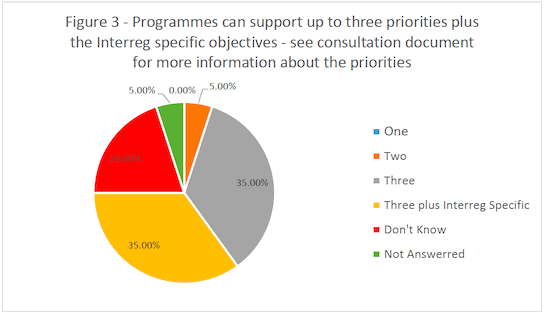
There is an even split between the proportion of respondents who are of the opinion that programmes should focus on three priorities, and of those who believe programmes should focus on three plus an Interreg Specific priority. As such, we are unable to reach a definitive conclusion on this particular question.
The current programmes cover specific priorities according to the common regional needs of those geographical areas they cover. Some respondents were keen to emphasise that a focus on rural, remote and island populations and their specific needs was important. Interestingly in this respect, Scotland’s inclusion in Pan European Programmes (currently Interreg Europe and URBACT) were noted as important as it allows cooperation with countries such as Greece and Italy (that the transnational programmes do not) and who face similar challenges due to having sparsely populated, island populations.
Other countries of note were Nordic and Arctic Countries as well as Ireland and Northern Ireland. These nations are part of a number of the same programmes that Scotland is currently part of. As such, these countries will be discussed in relation to the specific programmes of commonality.
Finally, Question 2 asked “How do you think working together with organisations from other countries could help you or your organisation or your members' organisations?” International cooperation through ETC is seen as a benefit to the majority of respondents for a wide range of reasons. One such reason is that it allows for cost effective piloting of initiatives by reducing “duplication of effort and ensure common understanding of the issues and potential solutions" according to one Scottish environmental body. This sentiment is echoed by Scottish Enterprise who, in their response state “Through cooperation, we have built critical mass to develop, test and pilot specialised/ innovative actions and activities in ways that would not be possible working in isolation."
Furthermore, ETC projects facilitate "Joint learning (at both organisational and individual level) leading to improved capacity" as stated by a regional business organisation. This learning also "helps to expand cultural awareness and potentially provide a better customer service to an increasingly multi-cultural population" in the view of a city council.
Overall, respondents agreed that Scotland should continue to participate in ETC programmes as they are a well-established way to facilitate meaningful and beneficial international collaboration (this was also noted in the Replacement for the European Structural and Investment Funds (ESIF) Post-EU Exit in Scotland: Consultation Report).
In conclusion, ETC is a well-established way to facilitate meaningful and mutually beneficial international collaboration. These programmes help to identify new solutions to common challenges in a cost effective way which minimises duplication by enabling the pooling of knowledge and resources. It allows partners to achieve “critical mass to develop, test and pilot specialised/ innovative actions and activities in ways that would not be possible working in isolation”. The key themes from the consultation responses were green and blue priorities (such as low carbon, blue economy, and renewable energy) as well as a Smarter Europe. Geographies of importance were the Island of Ireland, Nordic countries and island nations.
The following sections will look, in turn, at each of the current programmes that Scotland is involved in .
Atlantic Area
The Atlantic Area Programme currently brings together regions of France, Ireland, Portugal, Spain and the UK (specifically the West and North Coast of Scotland) to work on projects under the following objectives:
- Stimulating innovation and competitiveness
- Fostering resource efficiency
- Strengthening the territory’s resilience to risks of natural, climate and human origin
- Enhancing biodiversity and the natural and cultural assets
Many of the projects currently fall under the broad themes of a Greener Europe and Smarter Europe. They also cover Blue priorities including marine biodiversity and blue economies. Scottish project partners have received just over €5.2 million in the current programming period.
The post 2020 Programme will apportion the majority (likely around 70%) of its funding towards the priorities set out in the EU Atlantic Maritime Strategy. Priorities include sustainable and inclusive growth, protect, secure and enhance the local marine environment and reduce Europe’s carbon footprint. We therefore asked in our consultation what other priorities the 2021-2027 Atlantic Area Programme should focus on with the results in Figure 4.
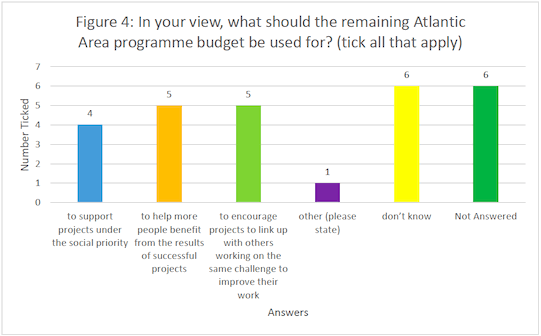
It is difficult from the above responses to deduce a consensus as to what other themes the programme could focus on. One comment from a Scottish forum pointed to potentially looking at urban, coastal areas in the Atlantic Area as well as rural ones. Another organisation suggested the programme could support projects in the cultural heritage and creativity space of Atlantic marine communities.
There was some concern noted about the current programme by a few respondents. A Scottish forum stated that the low success rate of Scottish partners in applying for funding could be due to thematic content and programme governance. The latter point was echoed by Scottish Enterprise who noted that the programme was difficult to engage with. However, they noted that this would not put them off participating in the 2021-2027 Atlantic Area Programme.
North Sea Region
The current North Sea Region Programme (NSR) includes EU Member States (Belgium, Denmark, Germany, the Netherlands, and Sweden) as well as non-Member States (Norway and the East Coast of the UK). The objectives for the 2014-2020 NSR are:
- Research and innovation
- Combatting climate change
- Environment and resource efficiency
- Sustainable transport and improved logistics
Scottish partners have been awarded almost €12.8 million in this programming period. Partners have been involved in a number of high profile projects that are part of this programming such as HyTrEc2 which has been nominated for a Regio Stars Award 2020. This project, which is led by Aberdeen City Council and includes Aberdeenshire Council, looked at improving innovation in the hydrogen vehicles sector. Aberdeenshire Council in their response noted that they would “strongly advocate” for Scotland to continue participating in this Programme in the 2021-2027 period.
This opinion was echoed by a number of respondents who saw a great deal of value in participating in the future NSR Programme. For instance, The East of Scotland European Consortium (ESEC) remarked in their response that the outcomes of one of their NSR projects, Northern Connections, “will contribute to the Scottish Government’s aim of transforming Scotland’s cities, towns and rural areas into places that support lower emissions lifestyles and businesses.”
Looking to the themes for the future programme, a number of respondents supported maintaining a focus on greener, low carbon priorities, particularly around the marine space due to the programme’s geography. However, when asked specifically on how much the programme should align with Scotland’s National Marine Plan, the majority of respondents indicated that it should only align “To Some Extent”. A breakdown of responses to the question are below in Figure 5.
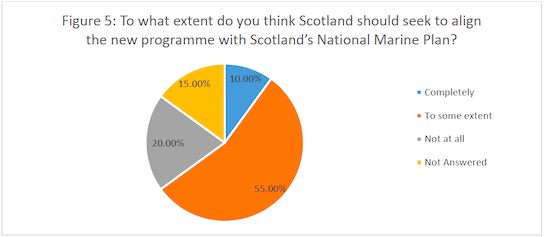
When analysing the long form responses, respondents believe that there should be more flexibility and wider scope for projects. One transport organisation argued that “Maritime issues should still be a major focus due to the geography of the programme, but other issues such as green transport, SME growth and connected communities are also important themes within the programme that could be lost if the focus was more narrowed." Other noted priorities included inclusive growth and youth education.
From the responses, one can draw the conclusion that this programme is highly valued and productive for the East and North Coast of Scotland. While green and blue themes are of value to the programme, it is important that the Scottish Government keeps other themes in mind, such as inclusive growth.
North West Europe
The 2014-2020 North West Europe Programme (NWE) is one of the biggest ETC programmes by population and budget size. The geographical area covers the whole of Belgium, Ireland, Luxemburg, Switzerland and the UK as well as regions of France, Germany and the Netherlands. The objectives for the current programme are:
- Research and innovation to improve the competitiveness of Small and Medium Enterprises (SMEs)
- Facilitating a low carbon economy
- Environment and resource efficiency
- Sustainable transport to reduce greenhouse gas emissions
This programme accounts for around 30% of all ETC funding awarded to Scottish project partners at €23.3 million. This, highlighted by a Scottish forum, “provides a good basis for further development in the 2021-27 period.” One of the projects that had been beneficial to Scotland under this programme according to ESEC was The ACE-Retrofitting project. This project, which Aberdeen City Council was involved in, “identified that the majority of buildings in North-West Europe are still energy-inefficient and in need of deep renovation, and aimed to empower local government with the skills to work with building co-owners and building experts, to ensure they would not be “locked in a high carbon future.” Such projects have helped to contribute to the Scottish Government’s commitments to reducing Scotland’s carbon footprint."
Further benefits of the programme come from its geography. Scottish Enterprise said in their response that “The programme geography includes other regions with high levels of innovation and is built-up compared to some of the other programmes Scotland has been eligible for.” Innovation was included as an important theme for inclusion in this programme by a number of respondents, including Scottish forums and a transport organisation.
In terms of how priorities and themes in this area could specifically be linked to Scottish Government policies, we asked which of Scotland’s National Performance Framework outcomes did respondents think the NWE programme should look to help achieve? The results are below in Figure 6.
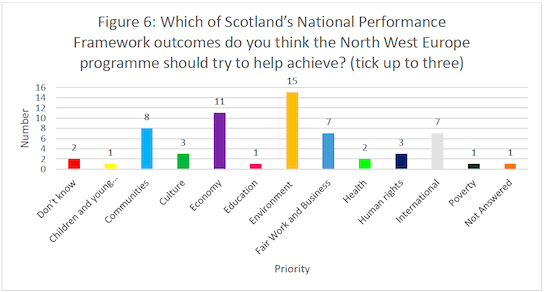
Once again we can see that the environment is of the most importance to those who responded to this question. An inclusive and sustainable economy was also highly valued as was the notion of improving communities in Scotland so they are inclusive and resilient. Should the 2021-2027 NWE follow similar themes to the current programme, then the themes that are important to our respondents would be fairly well reflected in the new programme’s themes.
Northern Periphery and Arctic
The Northern Periphery and Arctic Programme (NPA) is one of Scotland’s longest standing routes for facilitating cooperation between Scotland and our Nordic and Arctic neighbours. The Scottish Government’s Arctic Policy Framework, published last year, highlights the “strongly positive difference to our communities provided by NPA participation and has provided vital funding for local development”. In fact, around half of all NPA projects included a Scottish partner in the 2014-2020 period, which amounts to €7.3 million.
The current themes for the NPA are:
- Innovation to maintain and develop robust and competitive communities
- Promoting entrepreneurship
- Fostering energy-secure communities through promotion of renewable energy and energy efficiency
- Protecting, promoting and developing cultural and natural heritage
The NPA Programme is slightly different to the other programmes that Scotland is involved in due to the countries that make up the programme. In the current programme they include EU Member States Sweden, Ireland and Finland and non-EU Member States the Faroe Islands, Greenland, Iceland and Norway. However, a number of Canadian and Russian partners have also taken part in some NPA projects. Regions within Scotland and Northern Ireland are under the eligible area for this programme.
The geography of the NPA is advantageous to Scottish partners as stated by those who responded to the consultation. Historic Environment Scotland said that “The NPA Programme has provided a great channel to work with a unique set of countries…" This sentiment was echoed by other respondents including a business enterprise and The Convention of Scottish Local Authorities (COSLA).
Respondents identified a number of other benefits of this programme. One such benefit, according to a business organisation, is that there is an opportunity to apply for smaller preparatory and exploratory projects. This has helped with “connecting partners and building capacity in organisations which are small with no sufficient resources to develop a full Interreg proposal.” This way of working has also been utilised recently in a call specifically targeted at the Covid crisis response under objectives such as e-Health and economic impacts. This call is due to close 30th September 2020[5].
When looking to the future, we asked in our consultation “To what extent do you think Scotland should seek to align this programme with Scotland’s Arctic Policy Framework?” Similar to the results presented in Figure 5, we can see that respondents value a degree of flexibility with the majority voting that we should work for the NPA to align with Scotland’s Arctic Policy Framework “to some extent” in Figure 7.
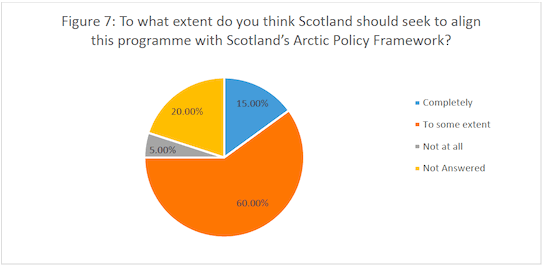
When giving detailed answers, those who answered the consultation were generally positive of the Policy Framework and its aims. However, it was felt that the Scottish Government should “not be limited to only those that relate to this policy as it risks missing several important themes.”[6] Additionally, it was felt that other policies should be taken into account when looking at priorities and themes for the NPA. Examples from Scottish Enterprise include The Nordic Baltic Policy Statement while a charity that responded suggested that The National Plan for Scotland’s Islands be consulted.
Nevertheless, there are a number of policy points within Scotland’s Arctic Policy Framework which are in line with views of those who responded to the consultation. For instance, green priorities including decarbonisation and the use of hydrogen fuels is noted in both. This was noted by a charity in their response stating renewable energy and green tourism should be considered for project objectives.
Tourism in remote and rural areas was seen as a key sector for support within responses and the Policy Framework. The current programme and previous programming periods have seen successful partnerships tackle this issue. The Policy Framework makes reference to Sustainable Heritage Areas, Partnerships for Ecotourism (SHAPE) project. SHAPE involves 33 associated partners from Scotland, Canada, Faroe Islands, Finland, Greenland, Iceland, Ireland, Northern Ireland, Norway, and Sweden. By working with private and public sector stakeholders, the project will create a public web-based service to “support organisations and communities with delivering effective ecotourism initiatives.”[7] Respondents to the consultation are keen for similar projects to build on this work, with the University of the Highlands and Islands saying these projects have been particularly beneficial to the area.
The theme of culture and natural heritage was more prevalent in responses under the NPA than other programme specific responses, which could be because it is currently the only programme that Scotland is involved in which has it as a specific priority for the 2014-2020 period. “The economic potential of cultural and heritage assets” that are common across the area should be leveraged whilst also being protected in the opinion of some respondents. Again, this theme is in parallel with the Arctic Policy Framework.
Finally, it is important to note in this section the importance of projects which focus on issues faced by remote, rural and island communities. These characteristics are common among other NPA countries and were highlighted a number of times by respondents as where much of the “focus” of the programme should be[8]. Comhairle nan Eilean Siar, in their comments, elaborated on potential projects with the theme of “more connected” in rural and remote areas such as “digital connectivity” and “the inclusion and development of coastal areas”.
Our analysis of replies to our consultation leads us to conclude that the NPA is of significant importance to respondents. This is due to its geography and themes including greener and connected themes. While respondents were keen to align our priorities for the future NPA “to some extent” to the Arctic Policy Framework, they also desired a degree of flexibility and consideration of other Scottish Government policies.
Interreg Europe
Interreg Europe is one of the two pan-EU programmes that Scotland has taken part in for the current programming. Non-EU states Norway and Switzerland also partake in Interreg Europe. The programme brings together local authorities and regional bodies (as well as some research organisations) to improve public services and policy. As stated by Aberdeenshire Council in their consultation response, "Participation in the programme can bring new perspectives to the design and delivery of policies and related services as well as encourage innovative thinking and inspire change from the status quo". The themes under the 2014-2020 period are:
- Research and innovation
- Improving SME competitiveness
- Facilitating a low carbon economy
- Environment and resource efficiency
Scottish partners have received just under €2 million during the current programme. While this is significantly less than the transnational and cross border programmes, these projects have proved valuable to Scotland. Interreg Europe participation has enabled Scottish partners to collaborate with European peers in a way that would not have been possible in transnational programmes. A consultation response from a business organisation noted that "One of the attractive features of the INTERREG Europe programmes is the lack of geographical constraints within the EU in terms of potential project partners. This helps widen the range of expertise that can be brought to bear on the topics identified in approved projects."
For example, the Cult Create project, which Dundee City Council is part of, is looking at the potential of Cultural & Creative Industries in developing new Cultural & Creative Tourism products and services for Growth & Jobs. The countries represented in the project are diverse and spread across Europe with Belgium, Cyprus, Greece, Hungary, Ireland, Italy, Latvia and Poland taking part. ESEC wrote in their consultation response “By collaborating with other local authorities, the City Council is improving its many policy instruments woven into its tourism strategy, to identify new actions and improve governance, all of which will contribute to Dundee’s aim of promoting its capacity for short cultural breaks, and to boost the value of tourism to the city from £146 million to £185 million." Because of its large geographical spread, this project would not have managed to achieve such a wide scope under another ETC programme which shows one of the benefits of the Interreg Europe Programme.
Respondents encouraged the continuation of focusing on better delivery of public service and policies, especially around “smart targets”[9] and “smart cities”[10] as well as projects linked to the Vanguard Initiative. Project aims are mainly around facilitating knowledge exchange but there is also the opportunity within the current programme to apply for funding to run Pilot Actions. Because of this, we asked whether this practice should continue in the 2021-2027 Interreg Europe Programme with results in Figure 8.
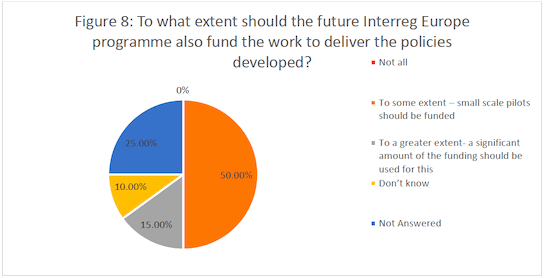
The majority of respondents that answered this question replied that “small scale pilot should be funded” but only 15% said that “a significant amount of the funding should” fund pilots. A business forum stated that their reason for arguing that only small scale pilots should be funded is that “Small scale pilots may enhance the visibility of the programme at local level but this has to be balanced at the additional pressure this will placed on what is likely to be a constrained overall budget. The experience of the current programme is that the level of demand for support from INTERREG Europe is very high. So the main consideration about the inclusion or otherwise of pilots should be about the improved effectiveness of the intervention and the capacity of the pilots to generate results relevant to the programme’s objectives."
Scottish Enterprise agreed with this thinking stating that "The programme future focus is a balancing act between funding fewer more strategic projects and continuing with high demand/number of projects. Perhaps the solution to could be to ensure that the programme results are translated beyond policy exchange to innovative market ready activities. This would also require greater alignment with other EU Programmes. For example, certain strands of Horizon 2020 could be used to commission calls geared up to take those pilots to the next innovation level." This could be one of the ways that the programme could move forward to balance the need for publicity with a scarcity of funding.
In conclusion, Interreg Europe, while not being the most successful for Scottish partners in terms of funding awarded, is still highly valued. This is because of its Pan-European reach and the opportunity to work with local authorities to improve public services through knowledge sharing and small scale pilots. Potential themes that were of importance to respondents to our consultation were largely under the Smart theme.
URBACT
URBACT is the second of the two pan-EU programmes that Scotland has taken part in for the current programming. Norway and Switzerland also partake in URBACT. As the programme name suggests, URBACT is aimed at developing inclusive and sustainable urban areas and cities by formulating networks to learn from one another and identify good practices. The five themes within the realm of improving urban areas which networks can target are:
- Physical urban development
- Development of local urban economies
- Environmentally sustainable cities
- Governance for sustainable cities
- Inclusion
Partners can apply to get funding for three types of interventions within the above themes: transnational exchanges, capacity-building, and capitalisation & dissemination. In the current programme, Scotland has been under represented and has only received around €40,000 of funding and have only been involved in two networks. This is significantly less than the previous programming period which saw Scottish cities involved in eight networks[11]. Glasgow City Council, for example, has been involved in both programming periods. One regional forum in their response said “A particular highlight of the Council’s activities within URBACT has been the Council’s work on integrating the city’s Roma community into the life and work of the city. This was catalysed by the ROMANET project in URBACT II. The council has however gone on to become a recognised example of good practice on this matter – long after the project itself came to an end."
It is also important to note that the overall budget for URBACT (€96.3 million) is much smaller than for Interreg Europe (€359 million) despite having the same geographical spread. Nevertheless, one individual said in their consultation response that "there seems to be a lot of money spent for little return in investment" for URBACT. On the other hand though, COSLA stated in their consultation response that, “URBACT amounts to a very small financial contribution but a large number of benefits around implementing the United Nations Sustainable Development Goals and engaging with other cities and local authorities.” The Scottish Government will of course take all views into account for this programme.
As URBACT is focused on urban areas and cities, our consultations asked how closely aligned the URBACT programme should be to the Scottish City Region Deal. Answers for this question can be seen below in Figure 9.
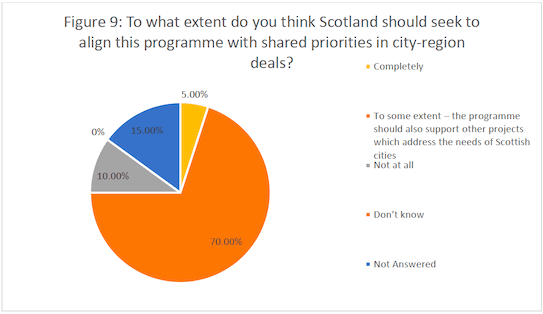
Again, we can see that a degree of flexibility is valued by respondents to our consultation with a sizeable majority stating that they would recommend align the city-regions deal to the URBACT programme “to some extent”. This is in line with our previous questions on to what extent other ETC programmes’ themes should align to specific Scottish Government policies. The reasons for this include that “some of [the deals] were agreed a few years ago and may have become dated" in the view of Scottish Enterprise. Moreover, one individual noted, “Scottish cities are now changed forever through the coronavirus impact. City region deals were designed before this challenge.” It is important therefore that we maintain a degree of flexibility when seeking to align the City-Region Deal with the design of the new URBACT programme.
In relation to specific themes, the importance of projects centred around “social inclusion”[12] was noted by some respondents. Specific aims of networks could focus on, as suggested by ESEC, include “urban renewal, school catering, intergenerational collaboration, reversing demographic decline, and social housing." This is particularly relevant in light of the Covid crisis. To quote one individual in their consultation response “Cities now need to put environmental and social concerns more prominently in their planning as they are not secondary considerations to the economic. The upcoming depression / recession is not a case of waiting for a return to normality…” While the Social theme did not come out strongly as a priority theme overall (See Table 1) it would appear that this theme is relevant to urban policies and therefore URBACT.
As with the other programmes, the Greener theme proved popular in responses specifically on the URBACT programme. An increased roll out of green infrastructure and sustainable transport were welcomed by a charity that responded as well as a transport partnership among others who responded to this consultation.
While Scottish cities have not been as successful in the current URBACT allocation compared to other ETC programmes that Scotland participates in, or previous programming periods, respondents were still relatively keen to partake in it. Social themes came out more strongly in relation to this programme compared to others with Greener themes also prominent in respondents answers. Meanwhile, there was a desire for more flexibility around alignment to the City-Region Deal and URBACT priorities. Qualitative analysis on this suggests that this is because specific City Deals were formulated a few years ago and that there were will be new challenges that now face cities, particularly in light of the Covid crisis.
Northern Ireland, Ireland and Scotland
Ireland, NI and Scotland currently participate in a cross-border programme which covers the west and north coasts of Scotland and the border counties of NI and Ireland. Project partners of this programme have secured the most funding from ETC programmes in Scotland with a total of €24.2 million approved. These themes for the current programme are:
- Research and innovation in health, life sciences, renewable energy and SME development
- Environment and resource efficiency around the sea basin
- Sustainable transport
- Social inclusion on a cross-border basis and to improve access to quality health and social care
At the beginning of 2019 it was announced that the current Peace IV Programme and the Ireland-Northern Ireland-Scotland Programme would be amalgamated into one successor programme – Peace PLUS – for the 2021-2027 period. The geographical area for the programme will focus solely on NI and the Irish border counties[13].
Because of this, in our consultation we asked “How do you think Scotland can best continue to collaborate with Ireland and Northern Ireland through ETC programmes?” The results are below in Figure 10.
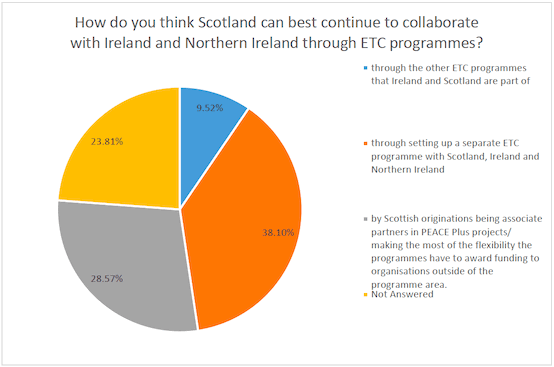
Continued cooperation in a limited geographical area – i.e. around the Irish Sea – is clearly favoured by respondents than simply collaborating through other ETC programmes that Ireland and Scotland are part of. However, the split between whether to do this through using geographical flexibility around functional areas within Peace PLUS or to set up a separate ETC programme is fairly even.
While Peace PLUS will be focused on Ireland and Northern Ireland, the European Commission have stated that the new ETC Programmes will be focused more on “functional areas” rather than strict eligible areas. That is to say, partner’s competence and relevance will be important rather than solely where they are based. What matters most is that the impact of projects be felt in the eligible area – in this case, the border between Ireland and NI. As such, there may be some scope for Scottish partners to be involved in Peace PLUS but this is not yet confirmed.
Despite the uncertainty of how Scotland may continue collaborating with the Island of Ireland through ETC, respondents were clear that they strongly wished to continue cooperation. One of the key reasons for this was because of Brexit, which was mentioned by a number of respondents. Aberdeenshire Council in their consultation response said “Given that Scotland may effectively become a gateway between the UK and EU Single Market (with Northern Ireland in the first and closely aligned with the latter), it may be appropriate to consider how co-operation programmes can facilitate greater connectivity between the island of Ireland and Great Britain."
The Covid crisis coupled with Brexit will result in a number of difficult challenges for Scotland, and the rest of the UK. UHI stated that “In this new policy context, it is essential that we take advantage of such partnerships and established relationships of trust [in the cross-bored programme] so that the focus can be on timely solutions for the difficult economic and social challenges ahead." Because of the geographies of Scotland, NI and Ireland, the continuation of cooperation is vital in this policy context.
In relation to potential themes that were of interest to respondents in this programming area, green and blue priorities were popular. Due to the geography primarily being based around the Irish Sea, The Scottish Islands Federation highlighted the potential for projects that focused on “low carbon solutions for ferries, transport on and off islands, wind and tidal and wave energy systems for the islands”. A government body added more by saying that it would be beneficial to have a “Focus of marine environment due to it being common border with mobile resources whose management/ utilisation/ enjoyment is common to all three administrations, and use this to encourage collaboration and sense of joint ownership/ connection to the sea."
Additionally, health and social care, which are priorities in the current cross-border programme, were also suggested as fruitful areas for projects in the next programming phase. As Scottish Enterprises noted in their consultation response, these projects could come under the Social theme (delivery of quality health and social care provisions) but also the More Connected theme (e-health). The Scottish Island’s Federation noted that the latter is very relevant for rural and remote populations.
Finally, while the theme was not so apparent in the comments for the other ETC programmes that Scotland is involved in, the importance of social cohesion was noted for this programme. Respondents understood that there is a unique need within this geography to look at “understand and reducing sectarianism”[14] and decreasing divisions within society as a whole. A charity said in their consultation response that projects focused on cultural and common heritage could be useful in this regard; "One of the aims should be to look at how culture can support communities and their development. In particular, culture can help communities to identify areas in common and celebrate these, as well as areas which may be more disparate and help them come together." This is, of course, a politically sensitive and dynamic area which should be treated as such.
The themes and priorities which have been highlighted by those who responded to our consultation correlate with the five proposed themes for the new Peace PLUS Programme[15]. Moreover, Scottish Enterprise note that “there is still a strong appetite for Scottish involvement with Irish and NI partners as evidenced by the welcomed response to [Special EU Programmes Body] SEUPBs Peace+ consultation.” The Scottish Government are encouraged by this and will continue to value our cooperation with the Island of Ireland.
Administrative Comments
To finish this section some comments about the running of the ETC programmes in general will be addressed, namely around the calls processes, audit and financial obligations and communication from programme bodies. While respondents were generally positive with the way that the majority of programmes are run, there were some issues that, if addressed, were felt would improve the programmes.
Firstly, respondents are keen for the calls process to be simplified among programmes. There was acknowledgement in consultation responses that the administrative process when applying for programmes could act as a barrier to smaller organisations. “Significant administration resource is required for proposal stages. If the application process could be streamlined across ETC programmes this would create time savings and efficiency at all stages, from application to evaluation. Administration support could be provided to those that need it to create a fairer process for all who could benefit or take part in projects."[16] To aid with this, one response from a charity stated that "Every effort should be made to keep application forms short, succinct, accessible to all and fit for purpose."
Further suggestions to aid Scottish partners, in the opinion of Scottish Enterprise, would be the aiding of "More cooperation and less competition during project calls and subsequent applications to allow for enhanced ‘matchmaking’ and likelihood of application success.” One of the ways to facilitate this which was suggested by Historic Environment Scotland in their response could be “"Earlier communication, including pre-notices, always welcome to allow for more time to assess opportunities and their suitability against our corporate objectives and outcomes, as well as finding partners."
Communication in general was picked up as an area for improvement by a number of respondents. Respondents consistently suggested that there be more communication to stakeholders about when funding calls were coming up through more channels, such as social media and more “community engagement”[17]. The use of “jargon free information in (online) materials and most importantly access to people who can give application specific advise prior to submission" was also proposed by a charity who responded to our consultation.
Further comments on communication highlighted the need for “properly resourced” and accessible National Contact Points (NCPs)[18]. This has been successfully utilised in the NWE and NSR programmes according to ESEC. In relation to these programme NCPs they said “When developing projects, having one named contact to deal with has always been very helpful, and allows for consistency, good knowledge of the timing of calls, and a real understanding of the project objectives on the part of the NCP." In addition to this, a local authority commented that it would be good if CPs "could be provided with scope to host national events in the lead up to calls, particularly early in the programme when there are likely to be more questions around the new operational programmes and possibly online systems too."
One criticism of the programmes has been their lack of communication of results from projects. One business enterprise said the following in their consultation response: “We would also like to see more effective and co-ordinated communication of results. It would be of benefit to have a platform for results, across specific themes to ensure legacy and added value." A transport partnership agreed and stated that the best way to enable this would be to have a "More systemic monitoring and reporting processes [which] would also allow for improved knowledge of eventual impacts and better benchmarking, as well as help improve communication of programme results."
This leads us onto our final topic within the matter of administration of current ETC programmes and improvements for their successors. The monitoring and reporting process for each programme is different and some are particularly complex. "Each of the programmes has differing reporting systems and this causes confusion for local authority finance departments, who do not always understand the difference across or within EU programmes” in the opinion of ESEC. Having a “consistent”[19] and “"As lighter touch as possible would be appreciated in some of the administration and audit requirements of these funds."[20]
A simple step forward in this regard would be a common Electronic Monitoring System (eMS) across the ETC programmes. "The proposal from Interact to develop a new monitoring system which would be common for all Interreg programmes is viewed very positively" by one business organisation who responded to our consultation. While this may not necessarily simplify the process for audits it would streamline them across the programmes which may alleviate some of the administrative burden for partners.
As stated by UHI, "There is always room for simplification of processes and governance and… Greater alignment across ETC programmes would also be helpful for applicants.” We thank respondents for their considered suggestions on improvements which could be made to ETC programmes to help partners get the greatest value out of participating in projects. We will reflect on these and try to work with partner countries to implement some of these ideas.
In summary, respondents valued each of the ETC programmes that Scotland currently participates in due to their varied themes and geographies covered. Greener and Smarter themes were most favoured by respondents but that did not negate the importance of other themes which should also be considered by the programmes. Furthermore, Nordic countries and the Island of Ireland were seen as strategically important for international cooperation for Scottish partners who responded to this consultation. However, they also saw great value in Pan-European programmes which allowed them to cooperate with countries not within the immediate geographical area of Scotland but nonetheless faced similar issues, particularly around island, rural and remote populations as well as coordinating on projects focused on tourism.
While there is room for improvement in regards to administrative issues with ETC programmes, on the whole respondents viewed them as well run. Communication is an area where it was believed better resourcing and wider use of different communication channels would improve the visibility of the programmes while simplification of calls and audit processes would be welcomed.
The Scottish Government thanks all respondents for their views and we will take them on board as we look to the 2021-2027 programmes which are currently being designed. Scotland’s participation in the future ETC programmes will be discussed in the following section which will also take Brexit and the current state of negotiations into account.
Contact
Email: ESF_Interreg@gov.scot
There is a problem
Thanks for your feedback